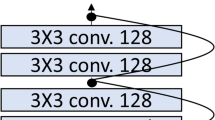Abstract
Training of a neural network is easier when layers are limited but situation changes rapidly when more layers are added and a deeper architecture network is built. Due to the vanishing gradient and complexity issues, it makes it more challenging to train neural networks, which makes training deeper neural networks more time consuming and resource intensive. When residual blocks are added to neural networks, training becomes more effective even with more complex architecture. Due to skip connections linked to the layers of artificial neural networks, which improves residual network (ResNet) efficiency, otherwise it was a time consuming procedure. The implantation of residual networks, their operation, formulae, and the solution to the vanishing gradient problem are the topics of this study. It is observed that because of ResNet, the model obtains good accuracy on image recognition task, and it is easier to optimize. In this study, ResNet is tested on the CIFAR-10 dataset, which has a depth of 34 layers and is both, more dense than VGG nets and less complicated. ResNet achieves error rates of up to 20% on the CIFAR-10 test dataset after constructing this architecture, which takes 80 epochs. More epochs can decrease the error further. The outcomes of ResNet and its corresponding convolutional network (ConvNet) without skip connection are compared. The findings indicate that ResNet offers more accuracy but is more prone to overfitting. To improve accuracy, overfitting prevention techniques including stochastic augmentation on training datasets and the addition of dropout layers in networks have been used.
Access this chapter
Tax calculation will be finalised at checkout
Purchases are for personal use only
Similar content being viewed by others
References
Detailed guide to understand and implement ResNets. CV (2019) Retrieved November 27, 2021, from https://cv-tricks.com/keras/understand-implement-resnets/
Bock S, Weiß M (2019) A proof of local convergence for the adam optimizer. Int Joint Conf Neural Netw (IJCNN) 2019:1–8. https://doi.org/10.1109/IJCNN.2019.8852239
Cs.toronto.edu (2022) CIFAR-10 and CIFAR-100 datasets. [online] Available at: https://www.cs.toronto.edu/kriz/cifar.html. Accessed 15 Dec 2021
Bishop CM (1995) Neural networks for pattern recognition. Oxford university press
Ripley BD (1996) Pattern recognition and neural networks. Cambridge university press
Venables W, Ripley B (1999) Modern applied statistics with s-plus
Lee CY, Xie S, Gallagher P, Zhang Z, Tu Z (2014) Deeplysupervised nets. arXiv:1409.5185
Szegedy C, Liu W, Jia Y, Sermanet P, Reed S, Anguelov D, Erhan D, Vanhoucke V, Rabinovich A. Going deeper with convolutions. In: CVPR
Raiko T, Valpola H, LeCun Y (2012) Deep learning made easier by linear transformations in perceptrons. In: AISTATS
Schraudolph NN (1998) Centering neural network gradient factors. In: Neural networks: tricks of the trade. Springer, p 207–226
Schraudolph NN (1998) Accelerated gradient descent by factor centering decomposition. Technical report
Vatanen T, Raiko T, Valpola H, LeCun Y (2013) Pushing stochastic gradient towards second-order methods–backpropagation learning with transformations in nonlinearities. In: Neural Information Processing
Srivastava RK, Greff K, Schmidhuber J (2015) Highway networks. arXiv:1505.00387
Srivastava RK, Greff K, Schmidhuber J (2015) Training very deep networks. 1507.06228
Hochreiter S, Schmidhuber J (1997) Long short-term memory. Neural Comput 9(8):1735–1780
He K, Zhang X, Ren S, Sun J (2016) Deep residual learning for image recognition. IEEE Conf Comput Vis Pattern Recogn (CVPR) 2016:770–778
Torch.ch (2021) Torch—exploring residual networks. Available at: http://torch.ch/blog/2016/02/04/resnets.html Accessed 26 Nov 2021
Nair V, Hinton GE (2010) Rectified linear units improve restricted Boltzmann machines. In: ICML
He K, Zhang X, Ren S, Sun J, Identity mappings in deep residual networks
TensorFlow (n.d.) The functional API, TensorFlow Core. [online] Available at: https://www.tensorflow.org/guide/keras/functional#a toy resnet model. Accessed 29 Nov 2021
Author information
Authors and Affiliations
Corresponding author
Editor information
Editors and Affiliations
Rights and permissions
Copyright information
© 2023 The Author(s), under exclusive license to Springer Nature Singapore Pte Ltd.
About this paper
Cite this paper
Borawar, L., Kaur, R. (2023). ResNet: Solving Vanishing Gradient in Deep Networks. In: Mahapatra, R.P., Peddoju, S.K., Roy, S., Parwekar, P. (eds) Proceedings of International Conference on Recent Trends in Computing. Lecture Notes in Networks and Systems, vol 600. Springer, Singapore. https://doi.org/10.1007/978-981-19-8825-7_21
Download citation
DOI: https://doi.org/10.1007/978-981-19-8825-7_21
Published:
Publisher Name: Springer, Singapore
Print ISBN: 978-981-19-8824-0
Online ISBN: 978-981-19-8825-7
eBook Packages: Intelligent Technologies and RoboticsIntelligent Technologies and Robotics (R0)




